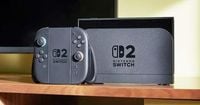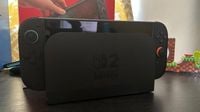On June 6, 2025, Nintendo officially launched the highly anticipated Nintendo Switch 2, ushering in a new era for handheld gaming enthusiasts worldwide. Priced at $449.99 (£395.99), this sleek device promises a blend of portability and power, featuring a custom Nvidia chip, a 7.9-inch LCD display capable of 1080p at 120Hz in handheld mode and 4K at 60Hz when docked. The launch has been met with excitement, curiosity, and a fair share of early user reports that paint a comprehensive picture of what gamers can expect from Nintendo's latest console.
One of the standout launch titles, Mario Kart World, has captivated players since its release on June 5, 2025. The racing game showcases the Switch 2's 120Hz refresh rate with smooth, zippy gameplay and vastly improved distance rendering compared to its predecessor, Mario Kart 8 Deluxe. Interestingly, a bovine racer named 'Cow' has taken the online lobbies by storm, becoming a fan favorite and a humorous highlight among the community.
Beyond new games, the Switch 2 breathes new life into existing favorites. Upgrades for The Legend of Zelda: Breath of the Wild reveal sharper character models, clearer rendering of distant objects, and dramatically reduced loading times, enhancing the beloved open world experience. However, the device's support for original Switch games comes with some caveats. Digital Foundry, a respected tech analysis team, has confirmed that while many original Switch titles run better on the Switch 2, including a remarkable performance doubling for notoriously problematic games like Batman: Arkham Knight, the resolution for these games remains capped at 720p in handheld mode. This results in some titles, such as Mario Kart 8 Deluxe, appearing less sharp on the Switch 2's larger, full HD screen due to upscaling.
Speaking of performance, the Switch 2 handles demanding titles like Cyberpunk 2077: Ultimate Edition with surprising finesse. The game runs smoothly in handheld mode, complete with commendable ray tracing effects. While the graphical fidelity doesn’t quite match the PS5's raw power—textures and distant details are less detailed, and some pop-in occurs—the Switch 2 delivers a fluid gameplay experience that belies its slim handheld form factor. Moreover, the Switch 2 outperforms the Asus ROG Ally in motion handling and power efficiency, boasting a battery life that far exceeds the Ally’s approximate 1.5-hour runtime during testing.
The console’s design reflects thoughtful refinement. It measures 4.5 x 10.7 x 0.55 inches and weighs 1.18 pounds (535 grams), sporting detachable magnetic Joy-Con controllers with HD Rumble 2 and a mouse sensor. These Joy-Con are taller and feature a matte finish, offering a more premium feel compared to the original’s plasticky texture. The thumbsticks have been improved with larger toppers and smoother glide, though they remain non-Hall effect. A curious design choice allows Joy-Con to be attached upside down or back to front, which some users find frustrating during initial setup.
The Switch 2 dock has grown chunkier, sporting a fully removable back panel that, while practical for cable management, is notably difficult to reattach due to tight pegs requiring careful alignment. Inside, the fan area is smaller than expected, yet the dock supports 4K output at 60Hz effectively. However, the popular Genki Covert Dock accessory, beloved by previous Switch owners for its compact HDMI output, does not function with the Switch 2, limiting travel-friendly display options.
Display-wise, the Switch 2 marks a departure from the original Switch OLED screen, opting for an LED panel that, while capable of higher refresh rates, sacrifices some vibrancy. Side-by-side comparisons reveal that colors like yellows and greens appear more muted, and HDR implementation can wash out bright scenes, particularly in handheld mode with games like Cyberpunk 2077. Turning HDR off often yields more realistic and inviting visuals.
On the software front, the Switch 2 maintains a familiar user interface closely resembling its predecessor’s. New features include GameChat functionality, Virtual Game Cards, and GameShare options, enhancing multiplayer and social gaming experiences. Screenshots are easier to manage now, automatically uploading to the user’s Nintendo account for seamless access on other devices. Mouse support is a notable addition, with wireless mice like the Logitech G Pro X Superlight 2 DEX and Alienware Pro Wireless functioning, though not all USB mice are compatible. The system slows mouse DPI settings considerably, which may affect precision gaming.
Controller support extends to the Nintendo Switch Pro Controller, which offers a softer touch and lighter back buttons with a satisfying click. However, its thumbsticks have a high deadzone, making fine aiming in games like Cyberpunk 2077 somewhat cumbersome. The Switch 2 also supports the GameCube controller, though wireless pairing requires an initial wired connection. Compatibility varies by game, with simpler control schemes like Mario Kart World faring better than complex fighters such as Street Fighter 6.
Early adopters have reported some launch issues. Several users encountered damaged consoles, broken seals, and even stapled receipts pierced through screens due to careless packaging by some retailers. Delivery delays and warehouse mishaps have also affected customers, with replacements ordered in some cases. Additionally, some users experienced a hard crash on the home dashboard during downloads, though these incidents appear isolated and without lasting damage.
Setup is straightforward and quick, taking approximately two minutes. Users are guided through detaching Joy-Con controllers and configuring their device. The game card slot mechanism has been redesigned with a sturdier metal folding piece, offering a smoother and more robust opening experience compared to the creaky flip of the original Switch.
The Switch 2 is not without its quirks. It takes slightly longer to wake from sleep mode compared to the Switch OLED, and tabletop mode still places strain on the lower USB-C port when peripherals are connected. Bluetooth headset support helps mitigate some port usage. The console's soft-touch finish, while premium, may be prone to scratches over time, a concern for some users.
Despite these minor drawbacks, the Switch 2 delivers a compelling package for gamers seeking a versatile handheld with enhanced performance and a growing library of titles. Its ability to elevate original Switch games, combined with native Switch 2 editions boasting 4K and 120fps capabilities, positions it as a worthy successor in Nintendo's lineup.
As the community continues to explore the Switch 2’s capabilities and software ecosystem, the console’s initial reception suggests a successful launch, marked by enthusiasm and thoughtful innovation. Whether diving into expansive open worlds, racing across vibrant tracks, or revisiting cherished classics with newfound smoothness, the Nintendo Switch 2 offers a fresh yet familiar playground for players around the globe.


